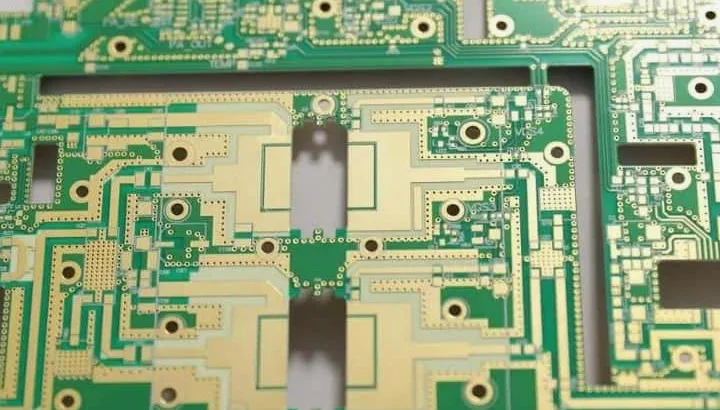At Highleap PCB, we specialize in manufacturing and assembling high-frequency PCBs, including all major Rogers PCB material families. Our advanced facilities and engineering expertise enable us to deliver high-performance RF circuit boards for demanding applications in 5G infrastructure, automotive radar, aerospace, satellite systems, and more.
If your next-generation electronic system requires low signal loss, thermal stability, and tight impedance control, Rogers PCB is the solution, and Highleap PCB is your trusted manufacturing partner.
Market Applications and Strategic Use Cases
Rogers PCB materials are engineered for industries where RF performance and environmental stability are non-negotiable.
- Automotive radar (e.g., 77GHz, 79GHz) relies on RO4000 series materials for their dimensional and dielectric consistency.
- 5G base stations and mmWave modules depend on Rogers TMM substrates to minimize power loss and support efficient thermal dissipation.
- Aerospace and defense systems—such as satellite comms and phased array antennas—choose RT/duroid materials for ultra-stable performance in extreme environments.
- Medical devices (MRI, imaging systems) utilize Rogers PCBs for their biocompatibility and signal clarity.
- Scientific and industrial RF instruments demand the low-loss, stable characteristics Rogers materials provide at GHz and mmWave frequencies.
Rogers PCBs ensure consistent performance in all these fields, where failure is not an option.
Rogers PCB Material Types and Performance Benefits
Rogers Corporation offers a range of RF-optimized materials. Each series meets specific design needs:
- RO4000 Series (e.g., RO4350B): Best for cost-effective, high-volume RF circuits up to 40GHz. It provides stable Dk (3.48) and low loss (0.0037 at 10GHz).
- TMM Series: Ceramic-filled PTFE materials designed for power amplifiers and beamforming units. TMM 10i, for example, has high thermal conductivity (2.4 W/mK) and exceptional electrical stability.
- RT/duroid Series: Ideal for aerospace/military. RT/duroid 5880 delivers ultra-low Dk (2.20) with minimal frequency variance.
- CLTE Series: Manages thermal expansion in mixed-material stack-ups (Rogers + FR-4).
- AD and DIALAM Series: Engineered for specific antenna and hybrid multilayer needs.
Choosing the right material depends on your operating frequency, power density, form factor, and budget. Our engineering team helps you match material specs to real-world performance needs.
Design Rules and Engineering for Rogers PCBs
Rogers PCBs require a tailored design approach that goes beyond standard FR-4 layouts. At Highleap PCB, we guide our clients through:
- Stack-up optimization: Multilayer stack design must align dielectric and copper layer thicknesses for target impedance.
- Impedance control: Rogers materials require tight tolerance control and careful field simulation to ensure signal integrity at high frequencies.
- Via reliability: PTFE-based substrates expand differently than FR-4; via design must prevent cracking under thermal cycling.
- Thermal engineering: High-power systems benefit from Rogers’ thermal conductivity, but need thoughtful via placement and copper pour for heat dissipation.
- Surface finish compatibility: Not all finishes (ENIG, OSP, immersion silver) react the same on Rogers. We adjust processes accordingly.
- Mixed dielectric handling: In hybrid PCBs (Rogers + FR-4), proper bonding prep and lamination strategy are essential.
Design-for-manufacturability (DFM) is especially important here—early collaboration saves cost and boosts yield.
Manufacturing Considerations and Process Control
Producing Rogers PCBs involves more than just switching materials—it requires dedicated processes and tooling:
- Precision drilling: PTFE and ceramic-filled laminates require special drill bits, speed, and evacuation techniques to avoid delamination.
- Routing and milling: Tool wear is faster due to hardness; process control is vital to maintain edge quality.
- Lamination: Different heat/pressure curves versus FR-4. Improper lamination leads to layer separation or skew.
- Plating and adhesion: Additional surface treatments are often needed for copper adhesion, especially on low-surface-energy substrates.
- Testing: Standard electrical tests may not reveal GHz issues. We offer high-frequency RF testing**, microsection analysis, and dimensional control under IPC standards.
At Highleap PCB, our lines are fully tuned for Rogers PCB production—including low-volume prototypes and high-volume orders.
Cost Drivers and Value Optimization
Yes, Rogers PCBs cost more—but for good reason. Material prices are only one part of the picture:
- Material cost: Rogers substrates are 5–15x more expensive than FR-4, depending on the series.
- Process complexity: Specialized drilling, lamination, and plating increase production time and tooling cost.
- Yield impact: Complex or tight-tolerance designs reduce yield—DFM can improve ROI dramatically.
- Volume: Small runs may carry high setup costs. Larger volumes allow economies of scale.
However, when properly applied, Rogers materials often reduce total system cost by enabling:
- Better signal integrity
- Lower power consumption
- Smaller device footprints
- Improved reliability
We work closely with clients to find the optimal balance between performance and cost.
Choosing the Right Manufacturing Partner
Manufacturing Rogers PCBs is not for every shop. You need a supplier with:
- Rogers-certified processes
- Proven design consultation for hybrid and RF stack-ups
- Advanced process control for drilling, lamination, and plating
- Reliability testing for high-frequency and thermal performance
- Global sourcing and scalability for large and small projects alike
At Highleap PCB, we’ve built our Rogers capabilities from the ground up. We support aerospace, telecom, automotive, and industrial clients with end-to-end RF PCB services—from material selection to final assembly and testing.
Ready to Build with Rogers PCB?
If you're developing radar systems, 5G modules, satellite transceivers, or any mission-critical RF equipment, Highleap PCB can help.
We manufacture every major Rogers material, offer complete PCB assembly, and deliver functional testing, programming, and enclosure integration—all under one roof.
📞 Contact us today and discover why engineers worldwide trust Highleap for Rogers PCB solutions that meet technical demands and delivery timelines.

